
This is the guy who got 81 million votes, okay?


Remember, the only way to get unapproved, experimental vaccines released under Emergency Use Authorization is if there are no other effective treatments available. If the Rule of Law still existed, Ivermectin would be the universal Corona treatment at all stages of infection and as a prophylactic, and all the bad actors executing the Great Reset would be, at minimum, in prison.

After COVID-19 emerged on U.S shores, providers began reviewing the emerging basic science, translational, and clinical data to identify potentially effective treatment options. In addition, a multitude of both novel and repurposed therapeutic agents were used empirically and studied within clinical trials.
The majority of trialed agents have failed to provide reproducible, definitive proof of efficacy in reducing the mortality of COVID-19 with the exception of corticosteroids in moderate to severe disease. Recently, evidence has emerged that the oral antiparasitic agent ivermectin exhibits numerous antiviral and anti-inflammatory mechanisms with trial results reporting significant outcome benefits. Given some have not passed peer review, several expert groups including Unitaid/World Health Organization have undertaken a systematic global effort to contact all active trial investigators to rapidly gather the data needed to grade and perform meta-analyses.
Data were sourced from published peer-reviewed studies, manuscripts posted to preprint servers, expert meta-analyses, and numerous epidemiological analyses of regions with ivermectin distribution campaigns.
A large majority of randomized and observational controlled trials of ivermectin are reporting repeated, large magnitude improvements in clinical outcomes. Numerous prophylaxis trials demonstrate that regular ivermectin use leads to large reductions in transmission. Multiple, large “natural experiments” occurred in regions that initiated “ivermectin distribution” campaigns followed by tight, reproducible, temporally associated decreases in case counts and case fatality rates compared with nearby regions without such campaigns.
Meta-analyses based on 18 randomized controlled treatment trials of ivermectin in COVID-19 have found large, statistically significant reductions in mortality, time to clinical recovery, and time to viral clearance. Furthermore, results from numerous controlled prophylaxis trials report significantly reduced risks of contracting COVID-19 with the regular use of ivermectin. Finally, the many examples of ivermectin distribution campaigns leading to rapid population-wide decreases in morbidity and mortality indicate that an oral agent effective in all phases of COVID-19 has been identified.

The entire history of this company looks like a shell game. More on that later. But first, check out this timeline, handily provided by the lead doctor assigned to the warp speed project trials, Lisa Jackson.

So prior to March 11th, 2020, Moderna had developed a vaxx, completed animal trials, and was now ready for Dr. Jackson to start jabbing humans. That seems really fast. Remember, March 11, 2020, we hadn’t even started 14 days to Flatten the Curve. So when had they first started working on this?
WSMA Reports: When news of the novel coronavirus started emerging from China, what was going through your mind? When did it become apparent to you that it could be a major threat?
Lisa Jackson: I was reminiscing at the start of the year about where my work stood in January 2020. KPWHRI had a small, but well-established, immunization study team, and it was winding down a couple of studies. The National Institutes of Health (NIH) had recently awarded us another round of Vaccine and Treatment Evaluation Unit (VTEU) funding: That meant our work was covered for the next 7 years, but we didn’t know what we would be doing; we thought probably some influenza vaccine trials and maybe even a malaria vaccine trial.
That all changed on Jan. 21. I was at the NIH that day for the kickoff meeting for the new funding cycle for the Vaccine and Treatment Evaluation Network, which includes KPWHRI and 9 other centers. We were all listening to a talk by Dr. [Anthony] Fauci regarding this new virus that had recently been identified in Wuhan, China. During that talk, all our phones started going off with the news that the first U.S. case of COVID-19 had been identified in a community near Seattle. https://www.kpwashingtonresearch.org/news-and-events/blog/2021/fighting-back-against-covid-19-remembering-historic-trial
All their phones started blowing up just as Blessed Fauci was making his pitch. Imagine that. Remember, at this same time (January 2020) the same Blessed Fauci was all over TV saying there is no risk to the U.S.
Next question, how long had Dr. Jackson and her team been working with Moderna on this new, never successful, mRNA biotechnology?
Lisa Jackson: Shortly after I flew back to Seattle, we received a notice that a vaccine was being developed for this new virus by the NIH and this company called Moderna, which no one had ever heard of. It asked for any VTEU sites interested in conducting the phase 1 clinical trial of this vaccine to apply. I consulted with my colleagues, Maya Dunstan and Barbara Carste, and we agreed to go for it. The next week, we were awarded that study. That was the end of life as we knew it.
Wait, what? Dr. Jackson and her team, the hand-picked vaxx trial coordinators, had never even heard of Moderna before the last week of January, 2020. But by March 11, they had a vaxx ready to go into human trials. Got it.
There is three-day seminar starting this Friday, April 30th. It’s free to sign up; you will be emailed login instructions. Link at the bottom… check out the epic list of presenters. See you there.




View the list of speakers, and register: https://www.restoretheculture.com/
You will need to spend some time with this. There is a significant amount of new material, and much of it needs digesting. I suggest reading it through the first time without pondering too hard, get yourself to the stunning conclusion, the re-read the whole piece with the conclusion in mind. This is steal trap logic, folks.
For some reason, the extensive footnotes would not populate, because WordPress. You will have to click over and review at his site.
Also, be sure to sign up for Dr. Mazza’s upcoming courses. I promise they are the highlight of my week, and I am sad when they are over. He does such a good job. Visit: https://www.edmundmazza.com/2021/04/27/158/
“Leave the Throne, Take the Ministry”: The Sacred Powers of Pope Emeritus
Edmund J. Mazza, PhD
“For the gifts and the call of God are irrevocable.” -Romans 11:29
“I became convinced that the commission of Peter demanded concrete decisions, insights, from me, but then, when it was no longer possible for me for the foreseeable future…the Lord…freed me from the burden…” -Pope Benedict, Last Testament with Peter Seewald, 2017
How does Pope Benedict understand the Papacy? To answer this question, we must first find out how His Holiness understands Sacred Power.
In the history of the Church, the Sacred Power (potestas sacra) of the clergy has been divided into two categories indicating two separate origins of that one power: 1) Power of Order (potestas ordinis) and 2) Power of Jurisdiction (potestas iurisdictionis, also known as missio canonica, or potestas regiminis).
The Power of Order is received at Priestly Ordination and gives power to a man to offer the Holy Sacrifice of the Mass and other sacraments. It changes a man ontologically: once made a priest, he can never be unmade a priest. His being receives a sacramental character that is indelible. As Rev. Pius Pietrzyk, O.P. writes: “although the Church acts as the medium through which a man is ordained, it is Christ who does the ordaining. The Church cannot undo what Christ has done.”
The Power of Jurisdiction, on the other hand, is traditionally understood as authority flowing from the Vicar of Christ and granted to bishops to govern specific dioceses. As Pietrzyk writes: “The whole reason for the developed distinction of the potestas iurisdictionis was that, unlike the potestas ordinis, it could be lost. Since sacred character cannot be lost, but potestas iurisdictionis may, it must have a different proximate source.” (emphasis mine)
To licitly exercise the Power of Order a man must first be in communion with the Pope and bishops. Even Vatican II recognized this: “Without hierarchical communion the sacramental-ontological munus [potestas ordinis], which ought to be distinguished from the canonical-juridical aspect [potestas iurisdictionis], cannot be exercised.” (emphasis mine) Passing over the issue of hierarchical communion, let us focus instead on the “buried lead” highlighted above: the Council affirmed that ordination gives a “sacramental-ontological munus” to the priest/bishop quite apart from any juridical/legal power of office/administration. Munus, in a strictly sacramental-ontological sense means gift that allows service; three gifts/services, to be precise, Christ’s own munera: priestly: to sanctify, prophetic: to teach, and kingly: to govern.
By adopting the language of “sacrament” over that of “statecraft,” the Council fathers were taking their lead in part from Pope Pius XII, who in 1947, issued a new document on the rite of ordination. None other than Joseph Ratzinger, in his 1987, Principles of Catholic Theology contrasts the change in theology between that magisterial document and previous ones:
The rite that Pius XII decrees represents a return to the form used in the early Church. It is pneumatologically oriented in terms of both gesture (since the imposition of hands signifies the conferral of the Holy Spirit) and word: the Preface is a petition for the Holy Spirit. Accordingly, the key word is now ministerium or munus: service and gift;
(emphasis mine)
The significance of this passage cannot be overestimated for anyone who has been following the controversy over Benedict’s own use of “munus” and “ministerium” in his February 2013 “resignation;” especially given his personal secretary, Archbishop Georg Gänswein’s words of May 2016:
The key word in that statement [Benedict’s renunciation] is munus petrinum, translated — as happens most of the time — with “Petrine ministry.” And yet, munus, in Latin, has a multiplicity of meanings: it can mean service, duty, guide or gift, even prodigy. Before and after his resignation, Benedict understood and understands his task as participation in such a “Petrine ministry [munus].” He has left the papal throne and yet, with the step made on February 11, 2013, he has not at all abandoned this ministry. (emphasis mine)
Benedict and Gänswein were roundly criticized by Catholic experts for this explanation, distinguished Church historian Dr. Roberto De Mattei among them:
If the pope who resigns from the pontificate retains the title of emeritus, that means that to some extent he remains pope. It is clear, in fact, that in the definition the noun [pope] prevails over the adjective [emeritus]. But why is he still pope after the abdication? The only explanation possible is that the pontifical election has imparted an indelible character, which he does not lose with the resignation. The abdication would presuppose in this case the cessation of the exercise of power, but not the disappearance of the pontifical character. This indelible character attributed to the pope could be explained in its turn only by an ecclesiological vision that would subordinate the juridical dimension [potestas iurisdictionis] of the pontificate to the sacramental [potestas ordinis].
It is possible that Benedict XVI shares this position, presented by Violi and Gigliotti in their essays, but the eventuality that he may have made the notion of the sacramental nature of the papacy his own does not mean that it is true. There does not exist, except in the imagination of some theologians, a spiritual papacy distinct from the juridical papacy. If the pope is, by definition, the one who governs the Church, in resigning governance he resigns from the papacy. The papacy is not a spiritual or sacramental condition, but an “office,” or indeed an institution. (emphasis mine)
“An ecclesiological vision that would subordinate the juridical dimension [potestas iurisdictionis] of the pontificate to the sacramental [potestas ordinis] is precisely how Benedict understands Sacred Power. Benedict is, in fact, diametrically opposed to De Mattei’s dictum: “The papacy is not a spiritual or sacramental condition, but an ‘office,’ or indeed an institution.” Expressing his sympathy for the view of the Orthodox churches of the East, Ratzinger writes:
Precisely this difference in the concept of authority grew steadily more intense and reached its climax in 1870 with the proclamation of the primacy of jurisdiction: in one case [traditional Orthodox view], only the tradition that has been handed down serves as a valid source of law, and only the consensus of all is the normative criterion for determining and interpreting it. In the other case [traditional Catholic view], the source of law appears to be the will of the sovereign, which creates on its own authority (ex sese) new laws that then have the power to bind. The old sacramental structure seems overgrown, even choked, by this new concept of law: the papacy is not a sacrament; it is “only” a juridical institution; but this juridical institution has set itself above the sacramental order.
Listen, furthermore to Ratzinger’s scathing criticism of the Church’s traditional understanding of the Power of Jurisdiction and “office” in contrast to the Power of Sacramental Order with regard to the priest/bishop:
While the medieval text…saw the ordination as resulting from the indicative of the conferral of power, ordination is accomplished according to the 1947 text…in the manner…of a prayer. Thus, it is apparent even in the external form that the true conferrer of power is the Holy Spirit, to whom the sacramental prayer is addressed, not the human consecrator.
The medieval rite is formed on the pattern of investiture in a secular office. Its key word is potestas…[however, since 1947] the key word is now ministerium or munus: service and gift;
The most crucial event in the development of the Latin West was, I think, the increasing distinction between sacrament [potestas ordinis] and jurisdiction [potestas iurisdictionis], between liturgy and administration as such…
I think we should be honest enough to admit the temptation of mammon in the history of the Church and to recognize to what extent it was a real power that worked to the distortion and corruption of both Church and theology, even to their inmost core. The separation of office as jurisdiction from office as rite was continued for reasons of prestige and financial benefits; (emphases mine)
Did Benedict just condemn the Church’s theology of potestas iurisdictionis? Did he just characterize her understanding of power of governance through office as something distorted and corrupt to the core?
Benedict, as it turns out, represents one of two schools of thought with regard to the ontology of Sacred Power. According to Msgr. Fredrik Hansen:
The first current [of thought] emanates from…K. Rahner, J. Ratzinger and Y. Congar…They all support the view that potestas sacra comes from the sacrament of orders [potestas ordinis]. In the case of the potestas sacra of the Bishop they advocate its complete origin in episcopal consecration [potestas ordinis]…Further this position teaches that also the power of teaching and governance comes from episcopal ordination although its exercise must take place within hierarchical communion. The missio canonica [potestas iurisdictionis] as the juridical
determination for the two latter powers [teaching and governance] renders this potestas sacra available for its exercise…The Primacy of jurisdiction of the Supreme Pontiff (cf. can. 331, PAE chap III, LG 18b) becomes difficult to explain in relation to this current. On a sacramental level (the power of order) there is no difference between the Roman Pontiff and the other Bishops of the Church. The difference in jurisdiction comes from a non-sacramental source…The power he then acquires comes directly from Christ, not from the election, and not from the College of Cardinals. (emphasis mine)
“The Primacy of jurisdiction of the Supreme Pontiff” does indeed “become difficult to explain in relation to” Ratzinger’s nouvelle theologie! Tradition teaches the Power of Jurisdiction can be lost! In which case, the justification for “pope emeritus” vanishes. Hence, De Mattei’s filial correction of Benedict and Gänswein for subordinating the Power of Jurisdiction to the Power of Order. The unfortunate truth, however, is that Benedict is unconcerned about accounting for the Primacy of Jurisdiction of the Supreme Pontiff. Witness what he had to say on the matter:
[Orthodox] Patriarch Athenagoras when he greeted the Pope [Paul VI in Jerusalem, 1964 exclaimed]: “Against all expectation, the bishop of Rome is among us, the first among us in honor, ‘he who presides in love’…” It is clear that, in saying this, the Patriarch did not abandon the claims of the Eastern Churches or acknowledge the primacy of the West. Rather he stated plainly what the East understood as the order, the rank and title, of the equal bishops in the Church—and it would be worth our while to consider whether this archaic confession, which has nothing to do with the “primacy of jurisdiction” but confesses a primacy of “honor” (τιμή) and agape, might not be recognized as a formula that adequately reflects the position Rome occupies in the Church—“holy courage” requires that prudence be combined with “audacity”: “The kingdom of God suffers violence.” (emphasis mine)
In one audacious sentence, Ratzinger completely side-steps the De Fide definition of Vatican I regarding the Supreme Power of Jurisdiction of the Pope! The Pope’s Power of Order suffices, it seems, to account for the essence of Who and What he is! He does not occupy “an office of jurisdiction,” which comes and goes, so much as a spiritual “office of rite” which is irrevocable:
The office of the papacy is a cross, indeed, the greatest of all crosses. For what can be said to pertain more to the cross and anxiety of the soul than the care and [personal] responsibility for all the Churches…attachment to the Word and will of God because of the Lord is what makes the sedes [throne] a cross and thus proves the Vicar [the Pope] to be a representative [of Christ].
But the witness is not an individual who stands independently on his own. He is no more a witness by virtue of himself and of his own powers of memory than Peter can be the rock by his own strength. He is not a witness as “flesh and blood” but as one who is linked to the Pneuma, the Paraclete who authenticates the truth and opens up the memory and, in his turn, binds the witness to Christ…This binding of the witness to the Pneuma and to his mode of being-“not of
himself, but what he hears” -is called “sacrament” in the language of the Church. – Sacrament designates a threefold knot—word–witness, Holy Spirit and Christ—which describes the essential structure of succession in the New Testament. We can infer with certainty from the testimony of the Pastoral Letters and of the Acts of the Apostles that the apostolic generation already gave to this interconnection of person and word in the believed presence of the Spirit and of Christ the form of the laying on of hands.
Here, allow me to go back once again to 19 April 2005. The real gravity of the decision [to accept the Papacy] was also due to the fact that from that moment on I was engaged always and forever by the Lord. Always – anyone who accepts the Petrine ministry no longer has any privacy. He belongs always and completely to everyone, to the whole Church…The “always” is also a “for ever”
Benedict “left the throne,” but “not his participation in the Petrine Ministry [munus].” In the Power of Order, it is not the Church, but Christ Himself who makes a man a priest. Thus, he cannot be unmade a priest. Likewise, Benedict seemingly argues, since it is Christ Himself and not the Church who makes a man a pope, he cannot be unmade a pope:
I had to…consider whether or not functionalism would completely encroach on the papacy …Earlier, bishops were not allowed to resign…a number of bishops…said ‘I am a father and that I’ll stay’, because you can’t simply stop being a father; stopping is a functionalization and secularization, something from the sort of concept of public office that shouldn’t apply to a bishop… He remains a father in a deep, inward sense, in a particular relationship which has responsibility, but not with day-to-day tasks as such… If he steps down, he remains in an inner sense within the responsibility he took on, but not in the function… one comes to understand that the office [munus] of the Pope has lost none of its greatness
Benedict went so far as to tell Seewald that the “office enters into your very being.” In fact, he once criticized Martin Luther precisely for misunderstanding the difference between office as jurisdiction (or function) and office as rite:
[For Luther] the priest does not transcend his role as preacher. The consequent restriction to the word alone had, as its logical outcome, the pure functionality of the priesthood: it consisted exclusively in a particular activity; if that activity was missing, the ministry itself ceased to exist…There was purposely no further mention of priesthood but only of “office”; the assignment of this office was, in itself, a secular act;
Benedict does not see the priesthood, or better yet, the papacy as “consisting exclusively in a particular activity, so that if that activity is missing, the ministry itself ceases to exist”:
My decision to resign the active exercise of the ministry does not revoke this…I am not abandoning the cross, but remaining in a new way at the side of the crucified Lord. I no longer bear the power of office for the governance [potestas iurisdictionis] of the Church, but in the service of prayer I remain, so to speak, in the enclosure of Saint Peter [potestas ordinis]. (Emphasis mine)
And in Seewald’s latest interview released in German in May 2020, Benedict doubles down on his “Petrine” status:
This word “emerito” meant that he was no longer an active bishop but was in the special relationship of a former bishop to his seat…the spiritual connection to his previous seat was now also recognized as a legal quality…It does not create any participation in the concrete legal content of the episcopate [potestas iurisdictionis], but at the same time sees the spiritual bond as a reality. So there are not two bishops, but there is a spiritual mandate [potestas ordinis], the essence of which is to serve from the inside, from the Lord, in praying with and for his previous bishopric. (Emphasis mine)
Seewald then directly asks His Holiness: “But does that also apply to the pope?”
It is not clear why this legal figure should not be applied to the Bishop of Rome either. In this formula, both are given no specific legal power of attorney anymore, but a spiritual assignment that remains – albeit invisible. This legal-spiritual form avoids any thought of a coexistence of two popes: a bishopric can only have one owner. At the same time, a spiritual connection is expressed that cannot be removed under any circumstances. (Emphasis mine)
But is Benedict’s ontological vision of the papacy an accurate one? As Hansen maintains, the other school of thought opposed to Ratzinger has centuries of tradition—and contemporary canon law behind it:
The second current of thought…makes a distinction between the episcopal consecration [potestas ordinis] on the one hand and the missio canonica on the other. The result is a position diametrically opposed to the first [Ratzinger’s] school of thought, holding that the power of governance comes from the missio canonica [potestas iurisdictionis] by which an office is entrusted…it allows an explanation of the difference between the Pope and the Bishops as regards jurisdiction…this second line of thought is echoed in the canonical doctrine found in the 1983 Code [of Canon Law] and the post-codal papal and curial documents, whereas the first [Ratzinger’s] is not: neither CIC 1983 nor Pastores gregis, or Apostolorum successores speak of power as the first current [Ratzinger’s] does…It is, therefore, important to underline that the distinction between the power of order and the power of jurisdiction was by the Council or Code neither negated nor suppressed, it remains a part of canonical doctrine.
(emphasis mine)
Or as De Mattei writes:
This doctrine [the distinction between Power of Order and Power of Jurisdiction]…has also been the common practice of the Church for twenty centuries, can be considered one of divine law, and as such unchangeable. Vatican Council II did not explicitly reject the concept of “potestas,” but set it aside, replacing it with an equivocal new concept, that of “munus.” Art. 21 of “Lumen Gentium” then seems to teach that episcopal consecration confers not only the fullness of orders, but also the office of teaching and governing, whereas in the whole history of the Church the act of episcopal consecration has been distinguished from that of appointment, or of the conferral of the canonical mission. This ambiguity is consistent with the ecclesiology of the theologians of the Council and post–council (Congar, Ratzinger, de Lubac, Balthasar, Rahner, Schillebeeckx…) who presumed to reduce the mission of the Church to a sacramental function, scaling down its juridical aspects.
The theologian Joseph Ratzinger, for example, although not sharing Hans Küng’s conception of a charismatic and de-institutionalized Church, distanced himself from tradition when he saw in the primacy of Peter the fullness of the apostolic ministry, linking the ministerial character to the sacramental (J.Auer-J. Ratzinger, La Chiesa universale sacramento di salvezza, Cittadella, Assisi, 1988).
Benedict would argue that Vatican II teaches: “the sacramental-ontological munus [potestas ordinis]…ought to be distinguished from the canonical-juridical aspect [potestas iurisdictionis]” (Lumen gentium AAS 57 (1965) 5-75 at 75.) This is why His Holiness went to great pains NOT TO RENOUNCE THE PETRINE MUNUS AS SUCH in his 2013 “Declaratio.”
But Vatican II was referring to the priesthood and episcopacy, not the papacy.
In the end, what Pope Benedict proposes regarding his ongoing Petrine status is, to use his words, audacious and violent. And if Benedict is objectively wrong, then when he renounced the throne thinking he could still keep the Petrine Ministry [munus], he committed a substantial error, invalidating his renunciation. Canon 332 §2 of the Code of Canon Law (1983) mandates that: “[i]f it happens that the Roman Pontiff resigns his munus, it is required for validity that the resignation is made freely and properly manifested…”
The ultimate question then is whether what was subjectively in Benedict’s mind was an accurate or erroneous understanding of the objective reality of the munus Petrinum in the Church’s ecclesiology. If one’s will acts on an erroneous appraisal presented to it by one’s reason, the WILL DOES NOT CHOOSE FREELY. Mistakes of this kind are most frequent in attempts at marriage. Marriage is an objective state of being that does not come into existence except from a free act of the will, which as we have seen, is dependent upon an accurate understanding on the part of reason:
error invalidates the act if it is an error concerning the substance of the act…Error affects
consent, for the will in an act of consent elects an object presented to it by the mind. If the mind is in error, the object is imperfectly or incorrectly presented and choice made upon such a premise is not always the same choice that would have been made if the object were correctly known. (Emphasis mine)
And we might add in closing, that according to the Church’s law, a resignation must also be “properly manifested” in order to be valid. But since objectively Benedict renounced “the ministry” of Bishop of Rome, and not the “munus,” there is ambiguity—not clear manifestation. In fact, even if ministry meant the same thing as munus in canon law (which it does not), or even if Benedict had explicitly mentioned “the munus” of Bishop of Rome, we could not be sure whether he meant munus as office [potestas iurisdictionis] in accord with canon law and centuries of tradition or if he meant munus as rite [potestas ordinis], which he has argued for decades is irrevocable.

Wow, the Philly case numbers must have totally flatlined, just like Arizona!
Nope. “Cases” are spiking, and are now higher than they were at the peak of the first wave.
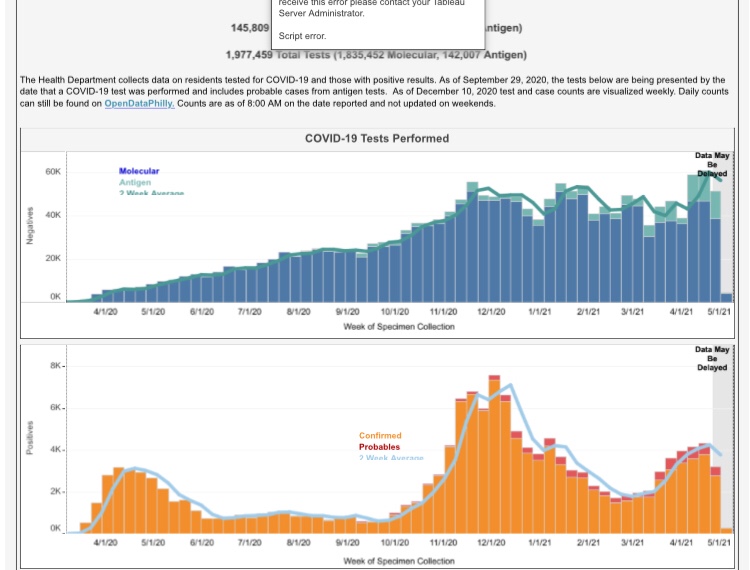
At least they are consistent with intentionally being wrong about everything all the time.
Also, no one wants the vaccine in Philly either:
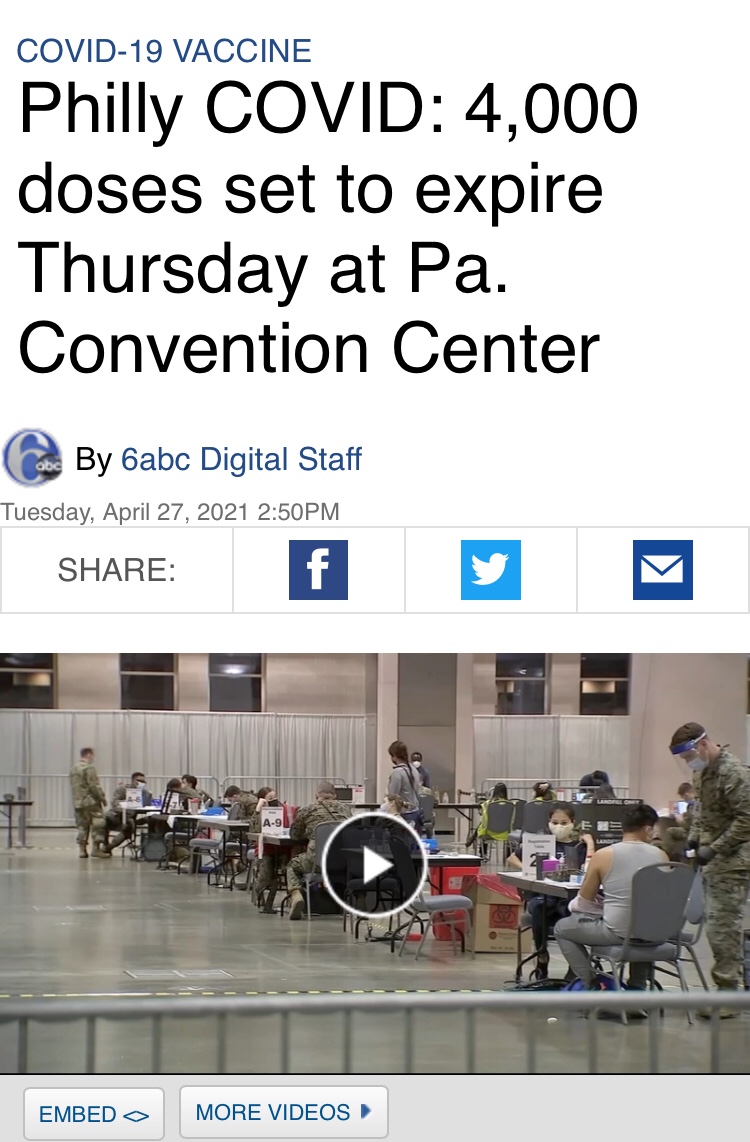
PHILADELPHIA (WPVI) — Philadelphians in need of a coronavirus vaccine are urged to stop by the Pennsylvania Convention Center this week.
The mass vaccination site has 4,000 extra doses that need to be used by Thursday.
“Come on out and get your vaccine. We’re doing dose one of Pfizer and you’ll set your second dose appointment here. We encourage all Philadelphians, or if you work in the City of Philadelphia, you’re also eligible to get the vaccine,” said Charlie Elison with FEMA.
Someone took the VAERS reporting data on death by vaxx, pulled the social media and newspaper headlines surrounding individual cases, and pasted it all into a google doc. Examples follow. Link at the end. Please help spread the word.
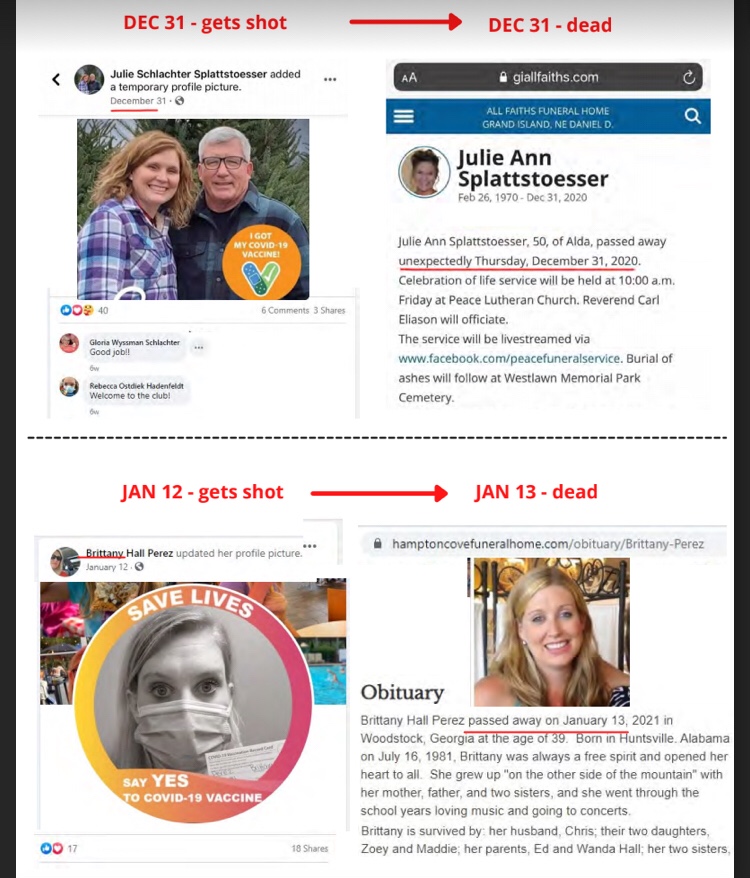


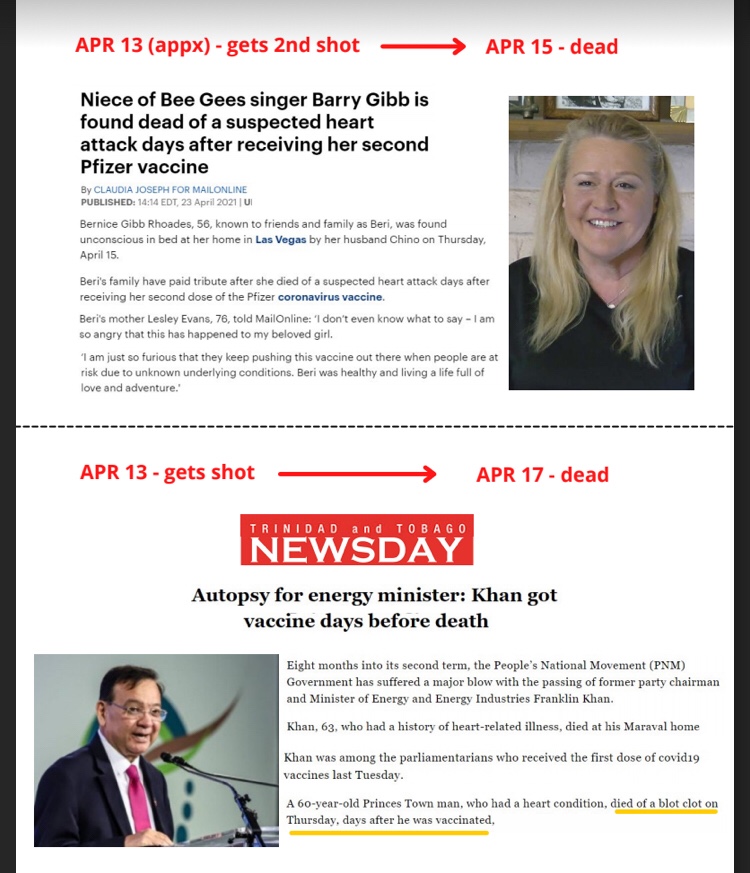
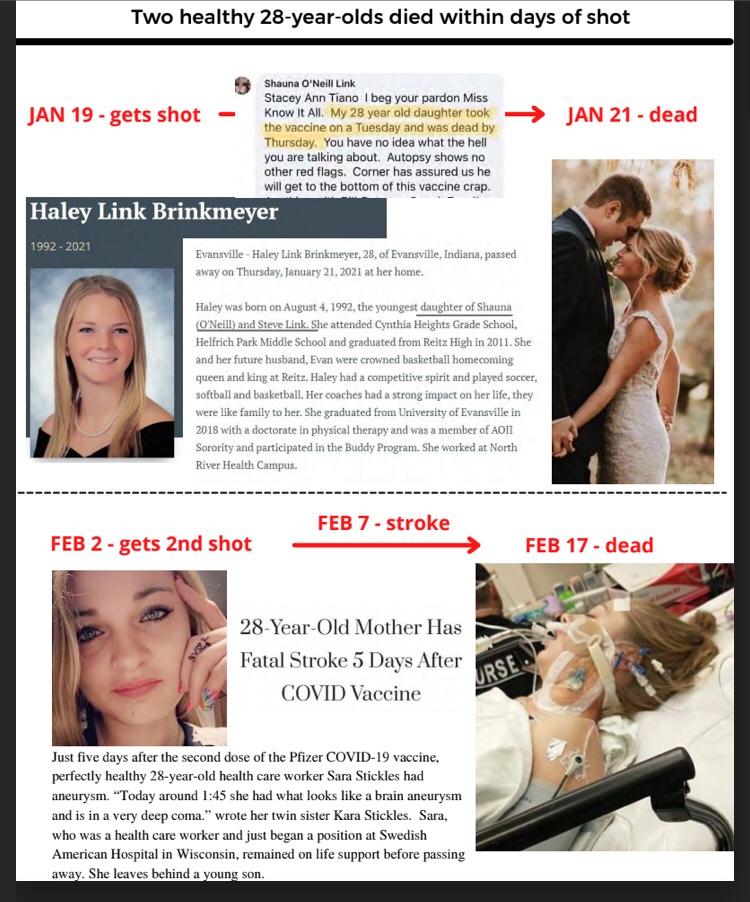





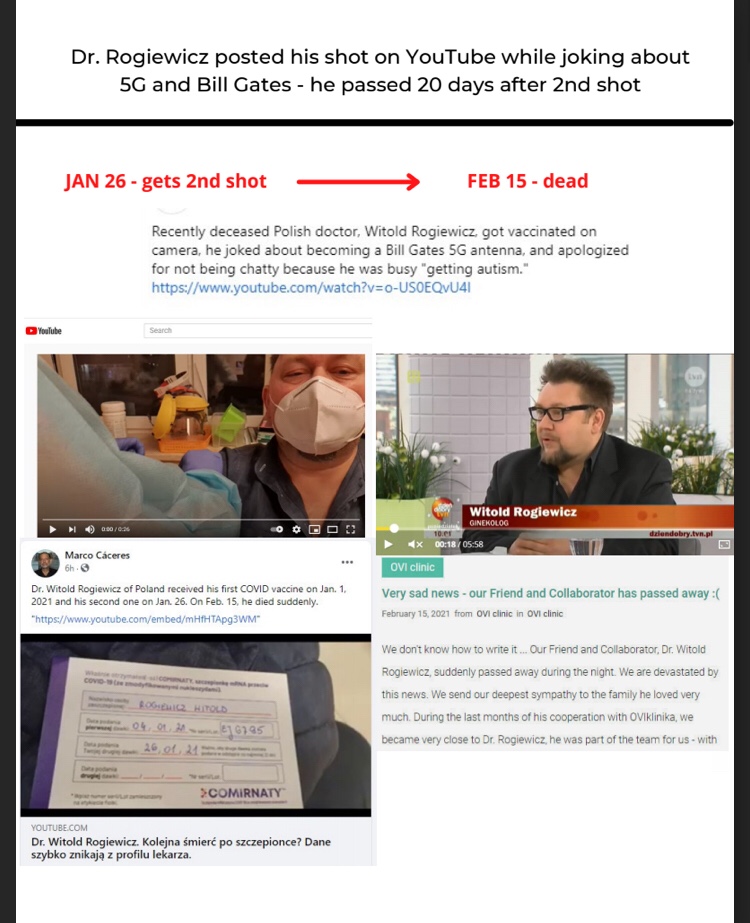
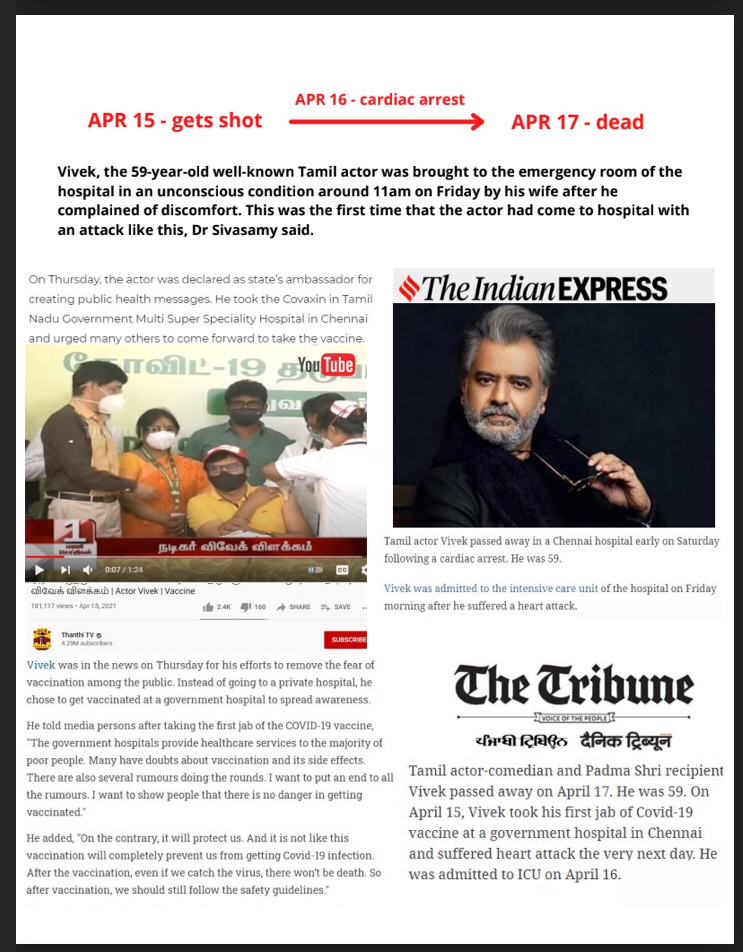
https://drive.google.com/file/d/1uS4krGJX-7sa8fuRlH7mhod-Xa5ZBsXU/view
From a doctor on the ground in India, who needs to remain anonymous.
Ivermectin is saving India. You just won’t hear about it on the news.



By Patrick Delaney
TULSA, Oklahoma, April 26, 2021 (LifeSiteNews) — Erin Maria Olzewski, the whistleblower nurse who made headlines last year documenting “fraud, negligence, and greed” that “led to unnecessary deaths” during the peak of the COVID-19 pandemic, sat down with LifeSiteNews during the Health & Freedom Conference to share her experience and reflections.
“The very first day [at Elmhurst] I was shocked. It was something I’ve never seen before,” she said. “Patients were alone in the rooms on ventilators [with] no family allowed in [to advocate for them]. People were just dying from gross negligence, medical malpractice, [and] mismanagement.”
“For me, that was really difficult to swallow. Everything made sense to me at that moment of why there were so many deaths in New York,” she said.
“I recorded them murdering patients. I recorded just the complete and absolute disregard for human life,” she said.
According to the video, Olzewski revealed how patients who repeatedly tested negative for COVID-19 were being described as “COVID confirmed” in their charts, which triggered a higher compensation from government payouts.
She contrasted the treatments that they had provided in Florida to what was happening in New York. “[In Florida] we treated our patients with hydroxychloroquine, zinc … sent them home and they were fine.” In New York, “they were banning alternative treatments like hydroxychloroquine. The only thing they could do was to put people on ventilators.”
At the time, the Department of Health and Human Services (HHS) provided what some called “perverse incentives” instituted by government COVID-19 relief funding, which awarded significantly more compensation to hospitals should patients be classified as COVID-19 positive ($13,000) or if they are put on a ventilator ($39,000).
Olzewski indicated these incentives dramatically impacted what was happening at Elmhurst. “You know, $13,000 to admit [COVID-19 classified] patients, and they were just admitting everybody.”
She further alleged that with the $39,000 incentive, the hospital would then put admitted patients “on a ventilator that they knew would kill them.” In addition, “in some cases” there was an incentive of “$10,000 [for] every death.” With families kicked out and not being able to monitor, it was “the perfect storm, and people took advantage of it.”
Well, that’s their story. Indeed, human trials did begin on March 16th, 2020. How did that happen? After decades spent working without success on both coronavirus vaccines and the mRNA biotechnology, how did that happen?
As I have published here before, take a look at what the “leading health experts” were saying just weeks/days before the miracle announcement of March 16th, 2020. Ask yourself, does this check out? Does this pass the sniff test?
Jan. 14, 2020: The WHO announces, “Preliminary investigations conducted by the Chinese authorities have found no clear evidence of human-to-human transmission of the novel coronavirus (2019-nCoV) identified in Wuhan, China.”
Jan. 19: The WHO: “Not enough is known to draw definitive conclusions about how it is transmitted, the clinical features of the disease, the extent to which it has spread, or its source, which remains unknown.”
Jan. 23: Anthony Fauci, director of the National Institute of Allergy and Infectious Diseases, says in a Journal of the American Medical Association podcast that the U.S. wouldn’t implement shutdowns of cities like what was occurring in China: “There’s no chance in the world that we could do that to Chicago or to New York or to San Francisco, but they’re doing it.”
Feb. 2: New York City Health Commissioner Oxiris Barbot tweets: “As we gear up to celebrate the #LunarNewYear in NYC, I want to assure New Yorkers that there is no reason for anyone to change their holiday plans, avoid the subway, or certain parts of the city because of #coronavirus.”
Feb. 7: Barbot assures residents, “We’re telling New Yorkers, go about your lives, take the subway, go out, enjoy life.” City lawmakers have called for Barbot to be fired because of the comments.
Feb. 9: Mark Levine, the chair of New York City Council health committee, tweets: “In powerful show of defiance of #coronavirus scare, huge crowds gathering in NYC’s Chinatown for ceremony ahead of annual #LunarNewYear parade. Chants of ‘be strong Wuhan!’ If you are staying away, you are missing out!”
Feb. 13: “There are ZERO confirmed cases of coronavirus in New York City, and hundreds of Chinese restaurants that need your business!” the New York City mayor’s office tweets. “There is nothing to fear. Stop by any Chinatown for lunch or dinner!”
Feb. 17: Fauci announces that the risk of coronavirus infection in the U.S. is “miniscule,” according to USA Today. Fauci also told the paper that people shouldn’t wear masks unless they are contagious.
Feb. 24: “It’s exciting to be here, especially at this time, to be able to be unified with our community,” House Speaker Nancy Pelosi, D-Calif., tells reporters as she visits San Francisco’s Chinatown. “We want to be vigilant about what is out there in other places. We want to be careful about how we deal with it, but we do want to say to people ‘Come to Chinatown, here we are — we’re, again, careful, safe — and come join us.’”
Mar. 2: “Since I’m encouraging New Yorkers to go on with your lives + get out on the town despite Coronavirus, I thought I would offer some suggestions,” New York City Mayor Bill de Blasio tweets.

Mar. 4: Barbot, the top New York City health official, declares, “There’s no indication that being in a car, being in the subways with someone who’s potentially sick is a risk factor.” On CNN, Anderson Cooper and Dr. Sanjay Gupta downplay the virus. “The flu right now is far deadlier,” Cooper says. “So if you’re freaked out at all about the coronavirus you should be more concerned about the flu, and you can actually do something about it, and get a flu shot.” Gupta responded, “15,000 people roughly have already died of the flu this season. Couple years ago, 60,000 people died of the flu.”
Mar. 9: At a Fox News town hall, Bernie Sanders says he would not close the border, even if it were necessary to halt the spread of coronavirus. He then attacked Trump’s “xenophobia.”
Mar. 10: The Big East Conference announced the Big East Tournament at Madison Square Garden will proceed as scheduled this week, saying that the New York City Department of Health and the New York City Office of Emergency Management are not recommending cancellation of large gatherings in New York City at this time.
Mar. 13: Two weeks to flatten the curve, universal shut down.
Mar. 16: Fauci: “Finding a safe and effective vaccine to prevent infection with SARS-CoV-2 is an urgent public health priority. This Phase 1 study (Moderna mRNA), launched in record speed, is an important first step toward achieving that goal.”
Is it just me?
Can someone explain how “warp speed” works, in a way that doesn’t involve sci-fi fantasy?
Timeline source: https://www.foxnews.com/politics/from-new-york-to-canada-to-the-white-house-initial-coronavirus-responses-havent-aged-well